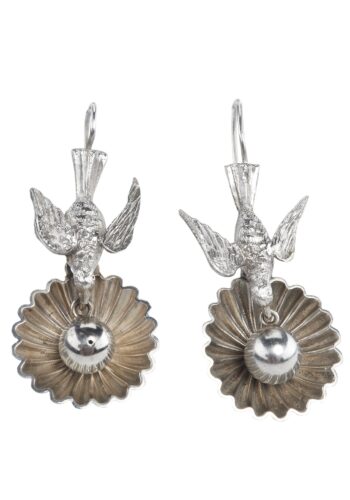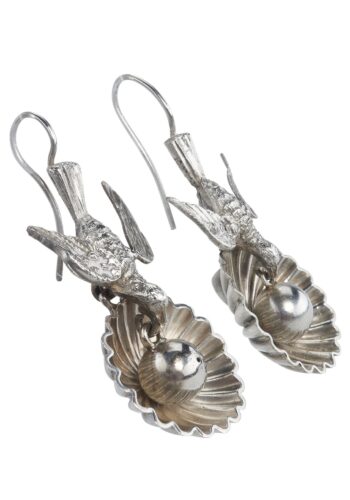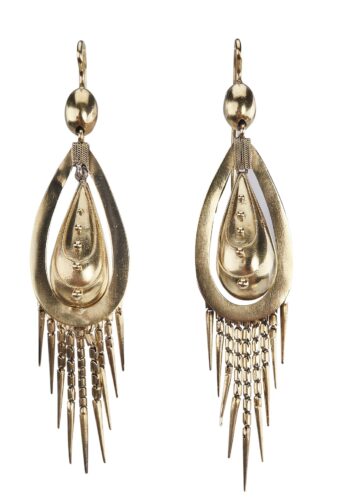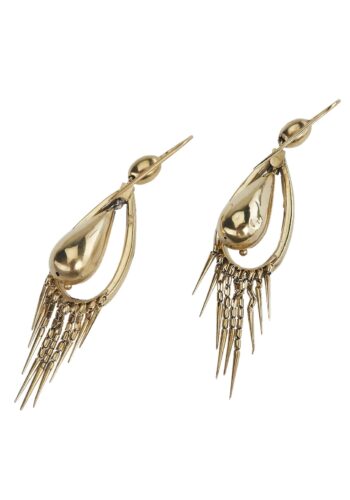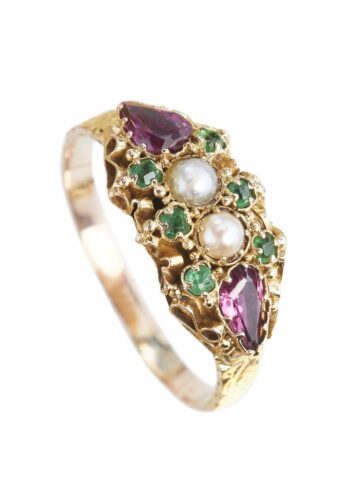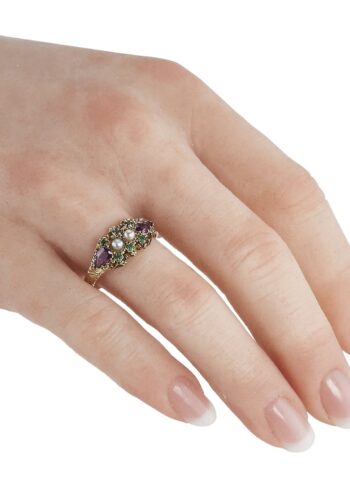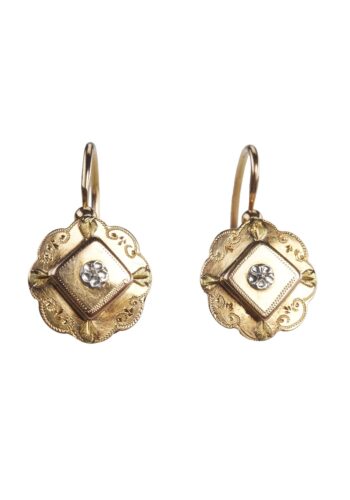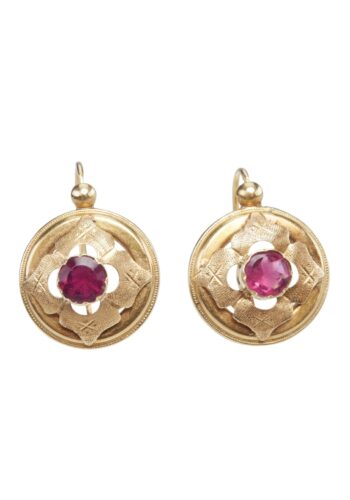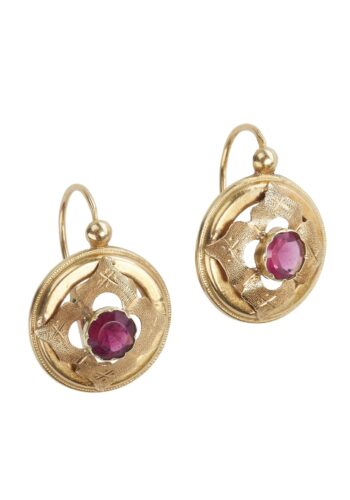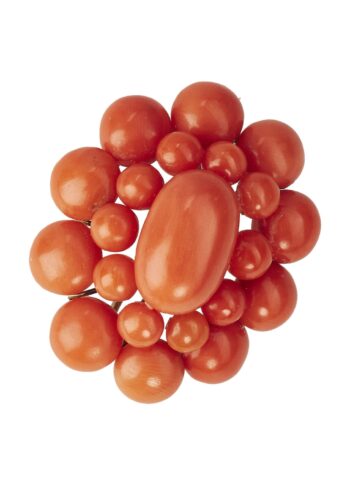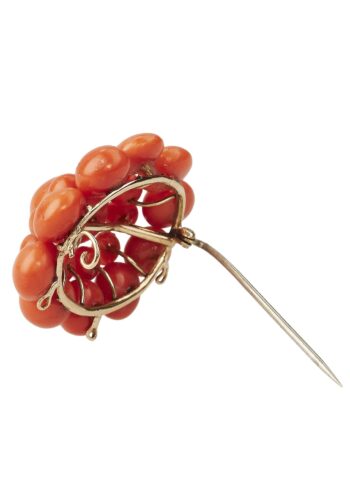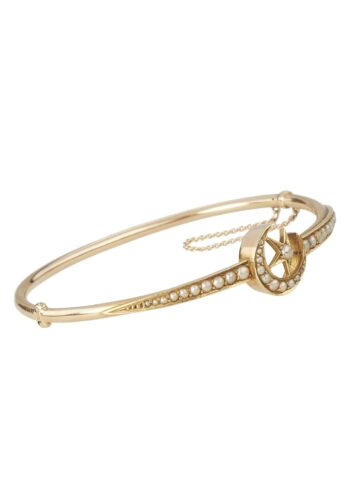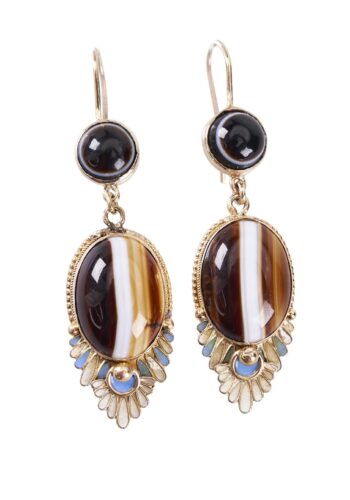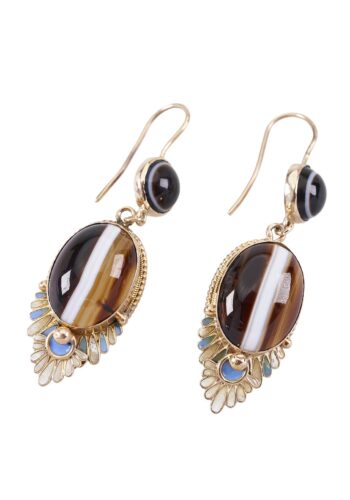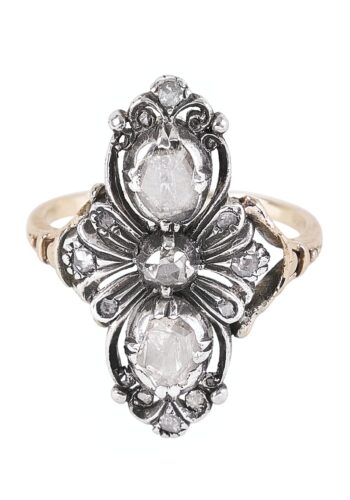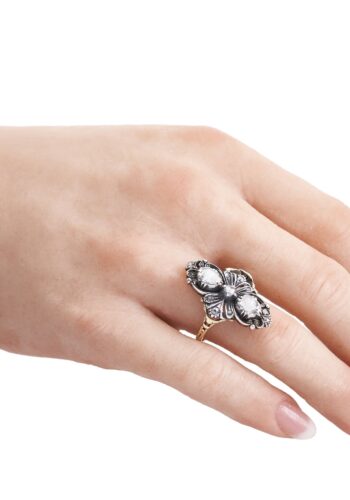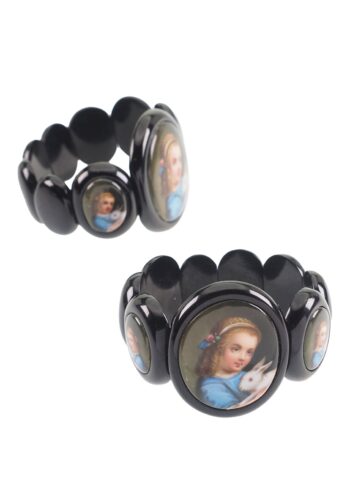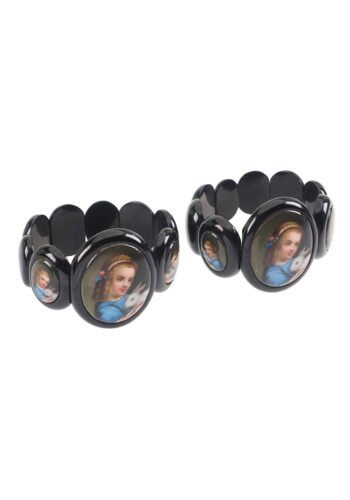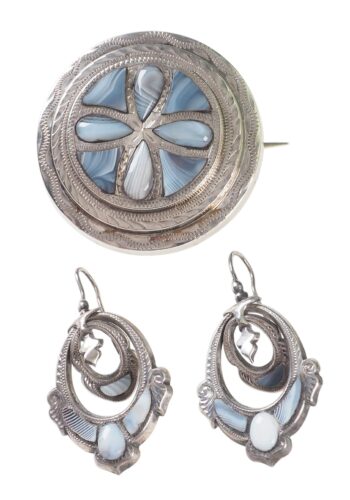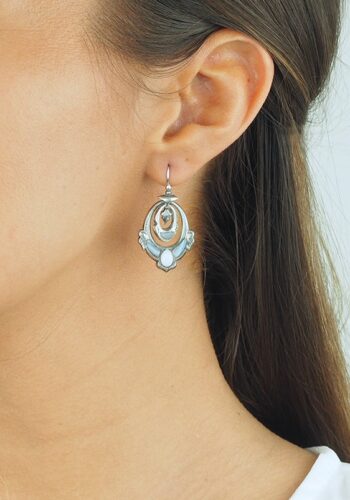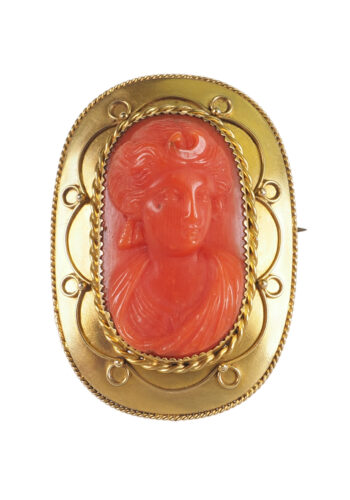
Victorian Jewellery< - 1837 to 1901
The Victorian era describes the long period of Queen Victoria's reign, which lasted 63 years. Trinkets that come from this era are called "Victorian jewellery". During the era, the British Empire experienced exorbitant expansion and became one of the four greatest powers in the world. British civilisation was pushed to all corners of the globe and unprecedented industrial and technological innovations changed people's everyday lives and enhanced their quality of life. The immense and well-founded evidence of the Empire's steep rise also makes persistent traditions of oppression, old-fashioned thought and action, and popular prudery seem questionable, but they also seem to have been a reality. It was the death of Prince Albert in 1861 that cast a great shadow over the splendour of the era. Suddenly Victorian mourning jewellery was widespread. Works made of the black material jet were ubiquitous as if from nowhere. The Whitbyjet claimed the highest level of quality. Exceptionally intricately hand-carved, faceted and polished, jet jewellery was worn as necklaces, bracelets and earrings. Motifs from flora and fauna were used for decorative purposes, as was typical for Victorian jewellery. Finely worked nuances and intricate hand engravings testify to the supreme artistry of the jewellers of that era. We distinguish 3 style epochs within the Victorian era, which perfectly reflect the circumstances of the century.
Early Victorian Age (1837-1860)
The Romantic Period
Queen Victoria (born Princess Alexandrina Victoria of Kent) ascended the throne in the heyday of the Romantic movement. Interest in the Middle Ages and the courtly life of the knights peaked in Sir Walter Scott's stories (e.g. "Ivanhoe") and Victor Hugo's "The Hunchback of Notre-Dame". In 1834, the so-called Tudor Gothic was chosen as the style inspiration for the new Houses of Parliament. What took place in literature and architecture was also reflected in jewellery design. Goldsmiths drew their motifs and designs from the Renaissance, the Middle Ages and nature. They adapted these themes without copying them exactly. The aim was to create an antique mood, not a replica. In addition to architectural influences, nature was also a great supplier of themes. Leaves, blossoms and branches are often found in jewellery design. The nature motif, however, most commonly found in the early Victorian era is the snake. As a symbol of wisdom and infinity, it had a much more positive connotation in this period than it does today.
Early Victorian Style Jewellery
Some materials define this epoch most aptly. These include Victorian hair ornaments: the finest spun yarns, braided and bobbed from hair, gifts as tokens of love and friendship. In addition, seed beads, which were sewn onto mother-of-pearl and produced highly astonishing ornaments. And last but not least, jett, the precious fossil material that made its debut at the London World Jewellery Exhibition in 1851 and went on to make jewellery history. To this day, antique Victorian jet jewellery functions as a companion to contemporary fashion because of its strong and confident statement. All in all, jewellery of this era reflects early Victorian society: enthusiastic, optimistic and curious.
Middle Victorian Age (1860-1885)
The Grand Period
When we think of Victorian jewellery in general, it is those large-scale, imposing and self-assured pieces of the middle period. It was not only the growing wealth of the population that was reflected in this style, but also the position of women, who were gradually encroaching on male domains. For example, it was revolutionary that they were allowed to keep their own earned money! Since 1870, they no longer had to leave their wages with their husbands. The Victorian jewellery of this period features motifs from ancient finds unearthed in Nineveh, Troy and Etruscan areas of Italy. High-quality examples emerged from the workshops of Giuliano, Castellani Froment-Meurice, Phillips and Brogden.
Victorian jewellery in the classical style had a rich setting of large coloured stones and the gold showed the typical surface of a peach skin. This was done by a process that gave the gold a matte, almost velvety texture. In the mid-1870s, tastes changed and the trend was towards colourless stones, primarily diamonds. This was probably due to the enormous diamond discoveries in South Africa. These mines, which only began to produce large quantities of the coveted stones in 1867, simply made them cheaper and accessible to larger sections of the population. Technical development also replaced the supremacy of coloured jewellery for a while. In the new and rapidly spreading electric light, diamonds sparkled with unusual strength and enthusiasm.
Victorian Classic Era Jewellery
If you are looking for antique Victorian jewellery from this era, you will find above all:
- Brooches
- Rings (engagement rings, wedding rings and "everyday rings")
- Earrings
- Bangles
- Colliers
Late Victorian Age (1885-1901)
Aesthetic period
The late Victorians looked with disgust at their parents' complacency and taste. They strove for a total break with tradition and in their zeal to undermine convention, they became romantic in a new way. From the Pre-Raphaelite painters' movement sprang the Art Worker's Guild, which introduced the public to craft art with its 1886 Arts and Crafts Exhibition. They propagated simpler materials and simpler forms. A revolution in general taste. Jewellery taste also became simpler. Less jewellery was worn in general. Wearing diamonds during the day was even considered the height of bad taste. In any case, so little jewellery was worn between 1887 and 1890 that the Jewellers Association turned desperately to Alexandra, Princess of Wales. She kindly bought some pieces from the Guild and wore them at public appearances. After that, the jewellery trade got back on its feet a little.
Victorian Watches, Victorian Earrings, Victorian Brooches
Watches were worn hanging from long chains and small earrings close to the ear. On evening occasions, such as a ball or a visit to the opera, diamonds were worn in filigree settings as necklaces. Hair ornaments such as combs or delicate tiaras, mainly set with diamonds and pearls, were also popular. They were set with motifs of stars, crescents, rosettes or crosses. Hardly a coloured stone was to be seen! In general, the colours of clothing became lighter, softer and more pastel; the use of velvet and lace declined. The jewellery design behaved accordingly. The stone that most aptly characterises this epoch, along with the diamond, is the opal. Society continued to favour moonstones and natural pearls. Small insects such as flies, butterflies or dragonflies were worn as brooches or as pendants on a plain chain or necklace. Likewise, diamond-studded owls, frogs, salamanders and other creatures are considered typical representatives of this era. The appearance of jewellery of the late Victorian period can hardly be called Victorian. It merged with the aesthetics of French "Art nouveau" and German Jugendstil. This presents the beginning of a new international taste and the start of the Edwardian era. One thing remained the same, however: the desire to own the ultimate best that money could buy. An attitude that had prevailed since the Great Exhibition of 1851. So the break with tradition was not as big as it seemed after all. Your interest in jewellery from bygone eras pleases both us and the environment: because our old Victorian jewellery is also sustainable jewellery Travel with us through the past in a resource-saving way and find individual, unique treasures! Also for the ball season!
Click to fold-
Ca. 1890 – Victorian Gold Earrings with a Pearl
€ 690,00
differential tax applies collectors items and antiques in accordance with German law §25a UStGFree Shipping -
Ca. 1880 – Victorian Sterlingsilver Bangle
€ 790,00
differential tax applies collectors items and antiques in accordance with German law §25a UStGFree Shipping -
Ca. 1900 – Sapphires & Diamonds Engagement Ring England
€ 1.990,00
differential tax applies collectors items and antiques in accordance with German law §25a UStGFree Shipping -
Ca. 1870 – Victorian Pinchbeck Earrings England
€ 790,00
differential tax applies collectors items and antiques in accordance with German law §25a UStGFree Shipping -
Ca. 1870 – Victorian Earrings England
€ 790,00
differential tax applies collectors items and antiques in accordance with German law §25a UStGFree Shipping -
Ca. 1870 – Victorian Gold Earrings, England
€ 1.790,00
differential tax applies collectors items and antiques in accordance with German law §25a UStGFree Shipping -
Dated 1897 – 15 Carat Goldlocket with Opal & Diamonds
€ 1.890,00
differential tax applies collectors items and antiques in accordance with German law §25a UStGFree Shipping -
Ca. 1860 – Victorian Ring England
€ 1.290,00
differential tax applies collectors items and antiques in accordance with German law §25a UStGFree Shipping -
Ca. 1890 – 18 Carat Gold Earrings Victorian, France
€ 590,00
differential tax applies collectors items and antiques in accordance with German law §25a UStGFree Shipping -
Ca. 1880 – Gold Earrings with Garnet France
€ 790,00
differential tax applies collectors items and antiques in accordance with German law §25a UStGFree Shipping -
Ca. 1880 – Etruscan Revival Gold Bangle with Diamonds
€ 5.500,00
differential tax applies collectors items and antiques in accordance with German law §25a UStGFree Shipping -
Ca. 1860 – Brooch with Coral Cabochos Gold
€ 990,00
differential tax applies collectors items and antiques in accordance with German law §25a UStGFree Shipping -
Ca. 1890 – Bangle 15ct Gold & Pearls Crescent Moon and Star
€ 1.490,00
differential tax applies collectors items and antiques in accordance with German law §25a UStGFree Shipping -
Ca. 1890 – 15 ct. Gold Necklace with Flower decor & Natural Pearls
€ 3.300,00
differential tax applies collectors items and antiques in accordance with German law §25a UStGFree Shipping -
Ca. 1890 – “Butterfly” Diamond Brooch / Pendant
€ 6.500,00
differential tax applies collectors items and antiques in accordance with German law §25a UStGFree Shipping -
Ca. 1880 – Sardonyx, Enamel & Gold, Victorian English Earrings
€ 1.990,00
differential tax applies collectors items and antiques in accordance with German law §25a UStGFree Shipping -
Ca. 1880 – Dutch Diamond Ring of 585 Gold & Silver
€ 3.300,00
differential tax applies collectors items and antiques in accordance with German law §25a UStGFree Shipping -
Ca. 1860 – One Pair Jet Bracelets with Porcelain Paintings
€ 1.490,00
differential tax applies collectors items and antiques in accordance with German law §25a UStGFree Shipping -
Ca. 1880 – 18 ct. Gold Brooch / Chain pendant with Cornelian cameo & Old-cut Diamonds, French
€ 3.500,00
differential tax applies collectors items and antiques in accordance with German law §25a UStGFree Shipping -
Ca. 1860 – Victorian Gold Ring with Emerald, Almandine & Pearl
€ 1.190,00
differential tax applies collectors items and antiques in accordance with German law §25a UStGFree Shipping -
Ca. 1870 – Pebbles Jewelry Set / Brooch & Earrings
€ 690,00
differential tax applies collectors items and antiques in accordance with German law §25a UStGFree Shipping -
Ca. 1890 – Diamond Brooch “Swallow” made of Gold & Silver, Victorian England
€ 2.500,00
differential tax applies collectors items and antiques in accordance with German law §25a UStGFree Shipping -
Ca. 1860 – 15 ct. Gold Brooch with Coral Cameo Victorian Italy
€ 1.290,00
differential tax applies collectors items and antiques in accordance with German law §25a UStGFree Shipping -
Ca. 1860 – Cut Steel Earrings, Victorian England
€ 690,00
differential tax applies collectors items and antiques in accordance with German law §25a UStGFree Shipping












